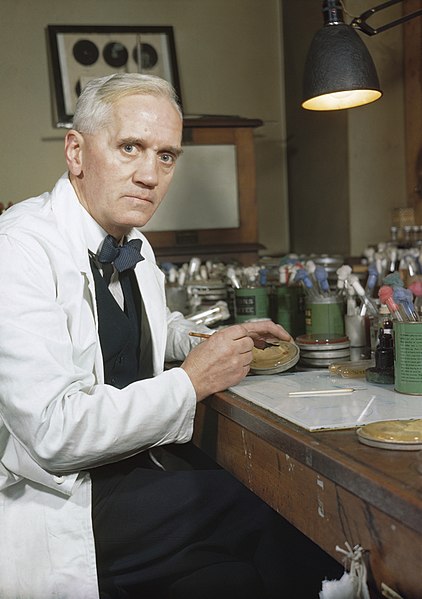پەڕگە:Synthetic Production of Penicillin TR1468.jpg

قەبارەی ئەم پێشبینینە: ٤٢٢ لە ٥٩٩ پیکسەڵ. ڕێزەلووشنەکانی تر: ١٦٩ لە ٢٤٠ پیکسەڵ | ٣٣٨ لە ٤٨٠ پیکسەڵ | ٥٤١ لە ٧٦٨ پیکسەڵ | ٧٢١ لە ١٬٠٢٤ پیکسەڵ | ١٬٤٤٢ لە ٢٬٠٤٨ پیکسەڵ | ٣٬٤٩٣ لە ٤٬٩٦١ پیکسەڵ.
پەڕگەی سەرەکی (٣٬٤٩٣ × ٤٬٩٦١ پیکسڵ، قەبارەی پەڕگە: ٣٫٩٣ مێگابایت، جۆری ئێم ئای ئێم ئی: image/jpeg)
مێژووی پەڕگە
کرتە بکە لەسەر یەکێک لە ڕێکەوت/کاتەکان بۆ بینینی پەڕگەکە بەو شێوەی لەو کاتەدا بووە.
| ڕێکەوت/کات | ھێما | ئەندازە | بەکارھێنەر | تێبینی | |
|---|---|---|---|---|---|
| هەنووکە | ٢٢:٥٠، ٤ی تشرینی یەکەمی ٢٠١٧ |  | ٣٬٤٩٣ لە ٤٬٩٦١ (٣٫٩٣ مێگابایت) | Ducksoup | Resolution 563×800, replace with 3,493×4,961 |
| ٢٣:٣٢، ٣ی شوباتی ٢٠١٣ |  | ٥٦٣ لە ٨٠٠ (٤٣ کیلۆبایت) | Fæ | {{Information |description = {{en|''Synthetic Production of Penicillin''<br/> Professor Alexander Fleming, holder of the Chair of Bacteriology at London University, who first discovered the mould Penicillin Notatum. Here in his laboratory at St Mary's,... |
بەکارھێنانی پەڕگە
ئەم پەڕەیە ئەم پەڕگەیە بەکار دەھێنێت:
بەکارھێنانی سەرانسەریی پەڕگە
ئەم ویکیانەی دیکەی خوارەوەش ئەم پەڕگە بەکاردێنن:
- بەکارھێنان لە ar.wikipedia.org
- ألكسندر فلمنج
- عقد 1920
- بوابة:أعلام/صورة مختارة/أرشيف
- المسيحية في المملكة المتحدة
- ويكيبيديا:صور مختارة/أشخاص/علماء
- ويكيبيديا:ترشيحات الصور المختارة/ألكسندر فلمنج
- ويكيبيديا:صورة اليوم المختارة/مايو 2021
- قالب:صورة اليوم المختارة/2021-05-22
- بوابة:أعلام/صورة مختارة/44
- ويكيبيديا:صورة اليوم المختارة/يونيو 2022
- قالب:صورة اليوم المختارة/2022-06-20
- مستخدم:رؤى فارس زهور/ملعب1
- اكتشاف البنسلين
- بەکارھێنان لە ar.wikiquote.org
- بەکارھێنان لە arz.wikipedia.org
- بەکارھێنان لە ast.wikipedia.org
- بەکارھێنان لە as.wikipedia.org
- بەکارھێنان لە az.wikipedia.org
- بەکارھێنان لە ba.wikipedia.org
- بەکارھێنان لە be.wikipedia.org
- بەکارھێنان لە bg.wikipedia.org
- بەکارھێنان لە bn.wikipedia.org
- بەکارھێنان لە ca.wikipedia.org
- بەکارھێنان لە cs.wikipedia.org
- بەکارھێنان لە cy.wikipedia.org
- بەکارھێنان لە da.wikipedia.org
- بەکارھێنان لە diq.wikipedia.org
- بەکارھێنان لە el.wikipedia.org
- بەکارھێنان لە en.wikipedia.org
- Alexander Fleming
- History of medicine
- Serendipity
- 1920s
- 1955
- University of London
- Culture of the United Kingdom
- Kilmarnock
- Talk:Alexander Fleming
- Portal:Medicine
- History of penicillin
- Kilmarnock Academy
- Wikipedia:WikiProject Scotland
- National symbols of Scotland
- User:Czar Brodie/sandbox
- Discovery of penicillin
بینینی بەکارھێنانی گشتی زیاتری ئەم پەڕگەیە.



